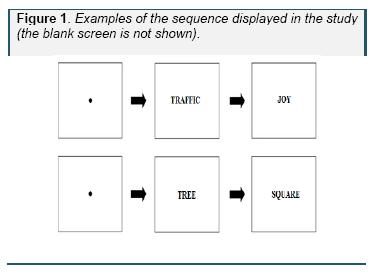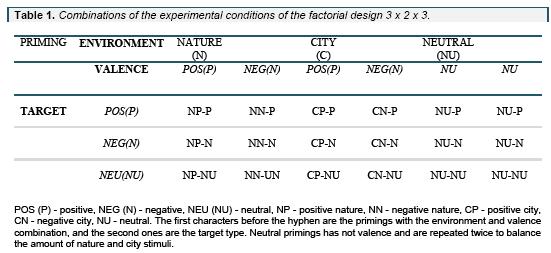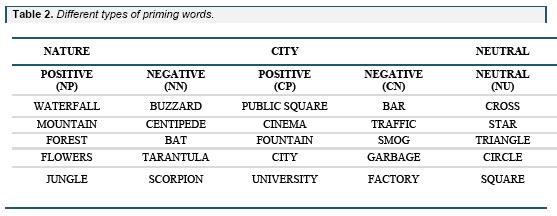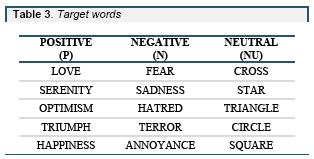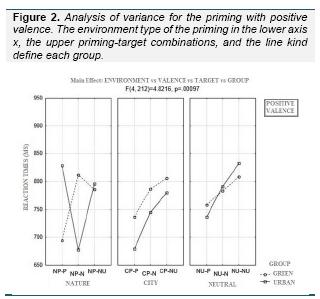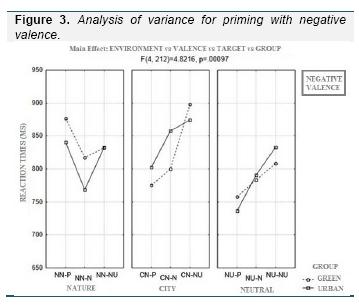Services on Demand
Journal
Article
Indicators
-
 Cited by SciELO
Cited by SciELO -
 Access statistics
Access statistics
Related links
-
 Cited by Google
Cited by Google -
 Similars in
SciELO
Similars in
SciELO -
 Similars in Google
Similars in Google
Share
International Journal of Psychological Research
Print version ISSN 2011-2084
int.j.psychol.res. vol.6 no.2 Medellín July/Dec. 2013
Study about the emotional valence of environmental concepts using affective priming technique
Estudio sobre la valencia emocional de conceptos ambientales utilizando la técnica de facilitación afectiva
Martha Patricia Sánchez Mirandaa,*, Arturo de la Garza Gonzáleza, María Lilia Rangel Sandovala
a Psychology department, Universidad Autónoma de Nuevo León; Monterrey, México
* Corresponding author: Martha Patricia Sánchez Miranda, Psychology department, Universidad Autónoma de Nuevo León; Monterrey, México, Email: marpa30@gmail.com
Received: 24-07-2013-Revised: 01-11-2013-Accepted: 14-11-2013
ABSTRACT
A quasi-experimental study was conducted with the affective priming technique in 62 students of psychology of a Mexican public university in order to determine if this paradigm is able to detect differences in emotional valence using related words to the natural and urban environments, when these are presented as congruent and incongruent primings to the target words. The findings suggest that exist two groups within the same sample by the kind of response to the positive priming of the nature, but it did not show the difference of the city assessment. It also shows an unexpected evaluation to the negative priminig of the city. Possible explanations to the phenomenon are discussed and the findings are compared with others researchers reports.
Key Words: Natural Environments, Urban Environments, Affective Priming, Emotional Valence.
RESUMEN
Se realizó un estudio cuasi experimental con la técnica de facilitación afectiva en 62 estudiantes de psicología de una universidad pública mexicana, con la finalidad de determinar si este paradigma es capaz de detectar diferencias en la valencia emocional de palabras relacionadas a ambientes naturales y urbanos, cuando son presentados como facilitadores congruentes e incongruentes con las palabras objetivos. Los resultados sugieren que existen dos grupos dentro de la misma muestra por el tipo de respuesta que expresan hacia los facilitadores positivos de naturaleza, pero no mostraron diferencia al evaluar los de ciudad. Asimismo, se encontró una evaluación inesperada a los facilitadores negativos de ciudad. Se discuten posibles explicaciones a este fenómeno, así también se comparan estos resultados con lo reportado por otros investigadores.
Palabras Clave: Ambientes Naturales, Ambientes Urbanos, Facilitación Afectiva, Valencia Emocional.
1. INTRODUCTION
The interest in studying the attitudes and values towards the environment is one of the most recurrent topics in researches to understand human behavior towards the same one. (Amérigo, Aragonés, De Frutos, Sevillano, & Cortés, 2007; González & Amérigo, 1999; Hernández, Suarez, Martínez âTovisco, & Hess, 1997; Milfont, 2010; Pato, Ros, & Tamayo, 2005; Schultz, 2002; Tacáks-Sánta, 2007; Vozmediano & Guillén, 2005). Attitudes are extremely important because they involve different dimensions of human behavior such as the cognitive, emotional and behavioral ones. One dimension intended to tackle in this research is the emotional field because of the impact it has on the modification of human behavior. As Pooley and O'Connor (2000) says, both emotions and knowledge are important for changing attitudes, and they should be integrated into environmental education programs. However, most programs are designed to contribute in knowledge acquisition placing somewhere else the emotional aspect (Valverde, Cano-Santana, Meave, & Carabias, 2005).
The study of environment and emotion is not new, there are some researches tackling this topic as one by Kals, Schumacher and Montada (1999), where they studied the emotional affinity with nature. To that end, they made a multiple regression analysis finding that emotions are useful to predict pro-environmental behaviors. Likewise, Hinds and Sparks (2008) found that emotional connection with nature is also a good predictor. On the other hand, the welfare that natural environment provides to humans has been studied by Nisbet and Zelenski (2011). They found that people who walk in green spaces reported that they feel happier than those who do it in enclosed areas.
In recent decades, the study of environmental identity and/or connection has begun. Their main interest is focused on building self-report instruments to measure the connection or connectivity and identity that humans have with the natural environment. Most findings show a link or a connection with it. (Clayton & Opotow, 2003; Mayer & Frantz, 2004; Nisbet, Zelenski, & Murphy, 2008; Schultz & Tabanico, 2007).
Sánchez, De la Garza, López and Morales (2012) made a graphic scale of environmental preference where they worked with 60 environmental images (30 from the city and 30 from nature). Participants had to decide how much linked they felt with the images in a 7-point scale. The findings identified in this research showed that images referring to forests landscapes, jungles and flowers are most valued regarding the relation, the same as city images referring their home place.
One of the biggest challenges of psychology is finding several tools to evaluate and detect possible changes on emotional aspects. As it has been aforementioned, most of researches are focused on explicit instruments (self-report), which gives an idea about how people feel. This can become a bias due to social desirability of their responses (Greenwald, 1990).
In the attempt to develop new ways of working with emotional dimension, different instruments to deal with these issues have been made such as affective priming.
1.1. Affective priming and implicit attitudes
One way to approach the problem about how humans process the environment emotionally can be achieve through the affective priming. According to this experimental paradigm, it has been found that we have cognitive mechanisms that allow us to automatically evaluate any type of emotional information, and is assumed that the information is organized in associative networks that are stored in long term memory. The associations that exist are not always the same, they will change depending on the experience that each individual has with the objects of reality (Fazio & Olson, 2003; Oskamp & Schultz, 2004). Thus, introducing objects activates an emotional assessment; they act as promoters of emotional valence and the underlying representation (Fazio, 2001; Hermans, Baeyens, & Eleen, 1998).
The technique to get closer to information processing is the affective priming that involves three stimuli, one corresponding to a specific point of attention, followed by the priming and finally the target, which is the stimulus to rate or on which the judgment is made. It should be mentioned that it should have a positive, negative or neither (neutral) emotional valence (Fazio, 2001).
Ratings or judgments are made from the presentation of priming stimuli and targets paired, which should be considered as congruent or incongruent; i.e., for the congruent pairs, it should exist a positive priming with a positive target or a negative priming with a negative target, while for the incongruent ones, the priming can be positive with a negative target and viceversa. It has been found in the researches made with the aforementioned paradigm that the reaction time is usually smaller when priming stimuli are congruent with the targets (Spruyt, Hermans, De Houwer, Vandromme, & Eelen, 2007). In addition, an important finding with the affective priming technique is that activation occurs automatically when the time interval between the priming onset and the beginning of the target is 300 ms (this is called SOA, stimulus onset asynchrony) and are presented without being aware of what lies behind the task. It is also common that with SOA of 300 ms, the reaction times are lower for targets with positive connotation than for the negative or neutral ones (Morales, Lopez, & Hedlefs, 2010).
Fazio and his team proposed a model for assessing implicit attitudes retaking the same ideas of affective priming paradigm. The implicit attitude from this model lies in presenting the attitude target as priming. The attitudinal assessment is through the so-called target, which consists of adjectives that will be associated with the priming containing emotional valence (positive or negative) or without valence (neutral). The task at hand is to decide if the word presented as target has or not emotional valence (Fazio, 2001).
Within the field of environmental psychology, it is being used implicit measurement instruments using response times. One of them is the IAT (Implicit Association Test). The studies that have been made regard implicit attitudes such as the one carried out by Sánchez et al. (2010). The findings of this study indicate that it is possible to detect within the same sample two different groups of people who have a positive attitude towards nature and another group in the opposite direction. Furthermore, it was also found that the participants of the two groups have a positive implicit attitude toward natural environments. This latter result is similar to the explicit instruments (González & Amérigo, 1999; Hernández et al., 1997; Schultz, 2002).
Another research line with implicit measurements has obtained results indicating an identity and a connection to natural environments (Olivos & Aragonés, 2013; Sánchez, De la Garza, & Lopez, 2009; Schultz, 2000; Schultz, Shriver, Tabanico, & Khazian, 2004). Similar findings were obtained with self-reports (Clayton & Opotow, 2003; Dutcher, Finley, Luloff, & Johnson, 2007; Mayer & Frantz, 2004; Nisbet et al., 2008).
Another implicit instruments used to a lesser extent are affective priming, such as the ones made by the team Korpela, Hietanen, Klemettilä and Kettunen. They investigated environmental scenes (images of both the city and nature) and quality of restoration. The results show that images cause emotional reactions considered as restorative stimuli, regardless of the type of targets presented (oral expressions of joy, anger and neutral). It was also found that in natural scenes, which are considered of major restoration, the reaction times are lower than the cases in which built environments are presented (Hietanen & Korpela, 2004; Hietanen, Klemettilä, Kettunen, & Korpela, 2007; Korpela, Klemettilä, & Hietanen, 2002).
As mentioned above, there are studies that tackle the emotions related to the environment, but most of them were focused on self-reports and only a few ones on implicit measures. It should be noted that there is a very limited number of articles with the affective priming technique in the field of environmental psychology and it has not been found anyone using words such as stimuli. In this situation the following hypotheses were proposed: As in previous studies, specifically with the IAT, two types of groups are detected in the same sample according to their responses. It was hypothesized: 1) If there are differences within the sample of individuals, it should be manifested itself in the reaction times for both congruent and incongruent pairs, whether of nature or city. And 2) If the affective priming technique is capable of measuring differences in responses to stimuli of different environments, it should be manifested in the response times by the individuals.
2. METHOD
This study has a quasi-experimental design with 3 factors as independent variables: environment with 3 levels (nature, city and neutral), valence with 2 levels (Pos, Neg) -these two factors are part of the priming-, and finally, the target with 3 levels (Pos, Neg and Neu). Combinations are shown in Table 1. The study aims to determine the emotional valence of words with environmental meanings and their behavior in terms of congruence - incongruence through reaction times as dependent variable. Words for environments of nature, city, and neutral were used as primings and emotional words as target. We will describe each one later.
2.1. Participants
The study sample is not random and convenience. It was attended by a total of 62 students who are studying psychology in a Mexican public university. They belong to the same socio-economic status (middle class) and live in the same city. The average age of the sample is 17.5 years and there is a balance among genders (48% males and 52% females).
The following exclusion criteria were followed for the study. Subjects with more than 20% of response errors were excluded and the reaction times that exceeded 1000 ms in the average of the test as well. Each answer was reviewed as a criterion of data cleaning and the wrong ones or times exceeding 1500 ms were replaced by the mean of the experimental condition where they were located. According to that exclusion criterion, 5 subjects were eliminated for errors excess, and 2 subjects who scored times above 1000 ms in the average of the test too. At the end, we worked with 55 participants' responses.
2.2. Instruments
A computer program developed in MS Visual Studio that runs on Windows operating system was used. Through this one, reaction times in milliseconds were obtained, which also facilitates database cleaning and formation. Lanix Neuron 2 Laptops with 14-inch screens set to the same brightness were used. The touchpad of all of them were disabled to avoid any interference with the test.
The study involved three stimuli presentation. The first one was an attention setting point in the middle of the screen per intervals of 500 ms. Then, a priming word appeared for 250 ms, followed by a blank screen for 50 ms (SOA 300 ms), and finally the target word. This value has been used previously in other studies (Morales et al., 2010). In the latter one, participants must answer if it has or not emotional content (Figure 1). The target word remained on the screen until there is a participant answer.
Priming words have both meanings of nature and city environments. These meanings were obtained by examining the content of images used in a previous study, in which the association degree that participants felt toward them was evaluated through a Likert Scale to select the highest and lowest scores (Sánchez et al., 2012). Furthermore, some words of geometric figures as neutral primings were included to have an experimental and comparison control. Priming words are shown in Table 2. Same quantity proportions and word types used were kept in the design (a third of nature, city and neutral, the latter ones were presented twice to balance the quantity with nature and city).
Target words were constituted by three types: words with positive, negative and neutral valence. Those with emotional elements were taken from previous studies where its content is known (Sánchez, De la Garza, & López, 2010). Those considered as neutral showed the name of geometric figures since they have not intrinsic emotional content and were included as experimental control and for comparison ends. Target words are shown in Table 3. Similarly, different types of target were balanced (one third were positive, negative, and neutral).
2.3. Procedure
Once students were invited to participate voluntarily, those who accepted were taken to an isolated room with low quantity of distractions. Once there, a computer was assigned for each one and then the study explanation was given. They were asked to look carefully at the computer screen. They were said that it would be a point in the middle of it, and immediately after, for a very short time, it would appear one word just to observe. Then, another word would appear and they should decide whether or not it had emotional content. The Z key with a NO blue label and the M key with a YES yellow label were assigned to their answers. They were asked to answer as quickly as possible. Ten priming-target stimuli pairs were presented to practice. If there was no doubt at the end, it would be proceeding with the study.
Each priming- target stimuli pair was presented in 5 blocks of 18 pairs, and all of them were randomly showed to each participant. There was a pause at the end of each block to rest if the subject needed. The quantity and the type of priming words, and the valence of target words were sought to balance.
3. RESULTS
A 10 version Statistica package was used to make the analysis. A meaning reference of p=.01 was considered. Because previous studies had observed different behaviors in answers within the same sample (Sánchez et al., 2009, 2010), it was proceeded to make preliminary classification of data where it was observed that participants had different reaction times to nature stimuli. Thus, the average time difference was established as the criterion for NP-P and NP-N condition. With this data, they were obtained 24 participants with less time for NP-P -we will call them green- and 31 participants with the opposite direction -we will call them urban-. This classification will be called as group.
With this preliminary classification, it was proceeded to make a discriminant analysis with the forward stepwise method to verify it. This involves analyzing all the variables and including only those that contribute to a better discrimination between groups. The results confirmed that there are two categories of participants. As seen in Table 4, the selected variables in the preliminary analysis were appropriate for classification. It can be seen that the values for NP-P and NP-N variables were the most suitable, followed by CP-P.
Furthermore, the same analysis showed that the initial classification was appropriate, since only four cases were changed of category as can be seen in Table 5. Final classification would be 22 green participants and 33 urban participants.
After this, an ANOVA 3 x 2 x 3 x 2 (environment x valence x target x group) for mixed designs was made. Results are shown in Figure 2 for positive valence priming and in Figure 3 for negative valence. As observed in Figure 2, priming nature with positive and negative target (NP-P and NP-N) have different responses for each group and equal ones for neutral targets (NP-NU), while city and neutral priming has similar responses to all the targets (CP-P, CP-N y CP-NU; NU-P, NU-N y NU-NU).
There isn't any important difference in the behaviors of each group regarding primings with negative valence that are shown in Figure 3, because the lines are almost parallel with little separation between them. Besides, it is observed the incongruence effect for nature primings i.e., the reaction time NN-P is higher than NN-N.
It should be pointed the behavior that both groups had for city primings in both valences. The response type is very similar in both graphics, even when they should show an opposite behavior. That is, due to the effect of congruence-incongruence between priming and target, it would be expected that times of CN-P are higher for CN-N (Figure 3), which did not occur.
With the aim of detecting if the behavioral differences between the two groups for environments of nature with positive primings (Figure 2) are meaningful, the following comparisons were done: In the NP-P condition, results showed that the difference between groups is significant, F(1,53) = 6.10, p=.001. About the NP-N condition, it was also meaningful F(1,53) = 12.81, p=.0007.
Summarizing, the main effect of the analysis between the priming valences, F(4,212)=4.8216, p=.00097, can be attributed to the phenomenon observed with positive nature primings since important differences were not observed in the other experimental conditions.
4. DISCUSSION
In the classification of the participants' sample, it was possible to observe that there where two groups of subjects according to the answer type to priming stimuli of positive nature (NP-P y NP-N), as it was demonstrated by the discriminative analysis. In this way, it is possible to detect differences within the same sample by their reaction time. Thus, hypothesis 1 is accepted.
According to the analysis of reaction time obtained during the study, it was found that participants facilitated the word stimuli when nature primings were presented. These results are similar to those obtained by other investigators (Hietanen & Korpela, 2004; Hietanen et al., 2007; Korpela et al., 2002). In their researches, they found that participants reacted emotionally to images of restorative nature. However, there are certain differences in the present research.
In the ANOVA analysis, it's possible to corroborate very different behaviors between the two groups. In the case of primings with positive valence (Figure 2), it is observed that there are two behaviors clearly distinguishable manifested in the answer type that they provide to the nature priming (NP-P and NP-N). This is interesting because if the words used are observed in detail in this experimental condition, it is hard to explain how the words forest, flowers, jungle, waterfall and mountain can facilitate the identification of target words such as fear, sadness, hatred, terror and annoyance for the group called urban. Given this conceptualization, it is possible to denominate this group as biophobic.
It is clear that valence in the latter words had a negative load, and it is counterintuitive that this group is congruent with primings according to the reviewed literature, where it is mentioned that incongruent stimuli are slower than congruent pairs (Morales et al., 2010; Spruyt et al., 2007).
It could be suggested that there is a negative association with nature in this students group. In the affective priming paradigm, information stored in long-term memory is activated when it is joined to emotional valence information, whether positive or negative, constructing the reality perception (Fazio, 2001; Hermans et al., 1998).
About the stimuli related to the city, it is observed that they do not interfere with the identification of the target types since it is recognized a similar behavior when they are shared with neutral primings. An interpretation for this could be that primings are congruent with the target valence and do not cause interference when they are assessed.
Regarding primings with negative valence (Figure 3), it was observed that answers were the expected ones in both groups for nature stimuli (NN-P y NN-N), but not in the city ones (CN-P y CN-N). It should be remembered that in this graphic, the incongruent conditions are the positive priming negative target pairs, which should have higher times than negative-negative ones (Spruyt et al., 2007). Nevertheless, this phenomenon is only seen in nature environmental primings, not in those relate to city. This is something that is also suggestive, words such as traffic, smog or garbage facilitates the recognition of other ones such as love, optimism and happiness. For this reason, it is possible to denominate them as urbanphilie, i.e. they present a positive relation to city. This information differs from previous investigations with explicit instruments where, seemingly, the participants have identified these stimuli of urban scenes with little relation to them and with negative connotation (Sánchez et al., 2012).
Summarizing, it is possible to affirm that the technical capacity of affective primings to measure emotional valence of words associated with nature can detect differences in the primings valence by the incongruent or congruent answer type. Besides, this capacity could be observed in the words related to city. That is why the hypothesis 2 is accepted.
In relation to the differences that have been detected from other investigations, it can be mentioned that the subjects who participated have very homogeneous characteristics; as for instance socioeconomic features, age, sex proportion, place of residence, and educative preference. Thus it would be very difficult to attribute these factors to the results found. For this reason it is necessary to search for other possible explanations. One of them could be the choice made of stimuli used as priming and targets. However, the latter ones are terms that have been successfully used in other studies (Sánchez et al., 2010). In the case of primings, they are concepts obtained from a previous study of environmental preference and are commonly used. Similarly, it could be argued that the experiment design influenced the answers. The problem with this reasoning is that the subjects had the same experimental conditions and were exposed to the same priming-target pair stimuli. Moreover, it could be contemplated that there is any kind of cognitive style in a subjects group that cause these answers types. The matter would be why it is just manifested in words related to nature of positive valence and not to city of negative valence, where both groups answered in a similar way.
In order to pose some possible explanations for these phenomena, we could suggest that answers, regarding stimuli of negative city, are those ones because the participants live in an urban environment where the reiterated experiences of these kinds of places lead them to process it as congruent in an implicit way. In the same way, the lack of contact with natural environments or bad experiences can whether guide to a negative conception or being dangerous, dirty or useless. This can lead a group of participants to evaluate negatively the words of positive nature. In this regard, it would be in accordance with Fazio and Olson (2003) who mention that emotional association made about stimuli depend on having experiences of reality. This situation could be interesting because they could be interfering with pro-environmental actions and lack of environmental problems awareness.
Nevertheless, it would be necessary to verify these situations and enquire subsequently about the association of these results with instruments that measure the environmental behavior. These matters allow the opportunity to explore possible causes for these phenomena. Currently, authors are working with variants of the instruments and other different ones to find answer for this question.
However, something that can be affirmed in the present research is that the affective priming technique is a useful tool to distinguish different behaviors when facilitating or interfering the subjects answers. Besides, it can be beneficial to detect the emotional assessment that people give to stimuli associated with different environments. For instance, this could be good for a research alternative about the explicit traditional techniques that are the most used and for the creation of evaluation instruments useful in environmental education courses; marketing matters; and the design of parks, buildings, etc.
5. REFERENCES
Amérigo, M., Aragonés, J., De Frutos, B., Sevillano, V., & Cortés, B. (2007). Underlying dimensions of ecocentric and anthropocentric environmental beliefs. The Spanish Journal of Psychology, 10(1), 97-103. [ Links ]
Clayton, S., & Opotow, S. (2003). Introduction: identity and the natural environment. In S. Clayton and S. Optow (Eds), Identity and the Natural Environment: The Psychological Significance of Nature (pp.1-24). Cambridge, MA: MIT Press. [ Links ]
Dutcher, D. D., Finley, J. C., Luloff, A. F., & Johnson, J. B. (2007). Connectivity with nature as a measure of environmental values. Environment and Behavior, 9(32), 474-493. [ Links ]
Fazio, R. H. (2001). On the automatic activation of associated evaluations: An overview. Cognition and Emotion, 15(2), 115-141. [ Links ]
Fazio, R. H., & Olson, M. A. (2003). Implicit measure in social cognition research: Their meaning and use. Annual Reviews Psychology, 54, 297-327. [ Links ]
González, A., & Amérigo, M. (1999). Actitudes hacia el medio ambiente y conducta ecológica. Psicothema, 11(1), 13-25. [ Links ]
Greenwald, A. G. (1990). What cognitive representations underlie social attitudes? Bulletin of the Psychonomic Sociery, 28(131), 254-260. [ Links ]
Hernández, B., Suarez, E., Martínez -Tovisco, J., & Hess, S. (1997). Actitudes y creencias sobre el Medio Ambiente en la Conducta Ecológica Responsable. Papeles del Psicólogo, 67, 48-58. [ Links ]
Hermans, D., Baeyens, F., & Eelen, P. (1998). Odours as affective-processing context for word evaluation: A case of cross-modal affective priming. Cognition and Emotion, 12(4), 601-613. [ Links ]
Hietanen, J. K., & Korpela, K. M. (2004). Do both negative and positive environmental scenes elicit rapid affective processing? Environment and Behavior, 36(4), 558-577. doi: 1177/0013916503261391. [ Links ]
Hietanen, J. K., Klemettilä, T., Kettunen, J. E., & Korpela, K. M. (2007). What is a nice smile like that doing in a place like this? Automatic affective responses to environments influence the recognition of facial expressions. Psychological Research, 71, 539-552. doi: 10.1007/s00426-006-0064-4 [ Links ]
Hinds, J., & Sparks, P. (2008). Engaging with the natural environment: The role of affective connection and identity. Journal of Environmental Psychology, 28, 109-120. [ Links ]
Kals, E., Schumacher, D., & Montada, L. (1999). Emotional affinity toward nature as a motivational basis to protect nature. Environment and Behavior, 31(2), 178-202. doi: 10.1177/00139169921972056. [ Links ]
Korpela, K. M., Klemettilä, T., & Hietanen, J. K. (2002). Evidence for rapid affective evaluation of environmental scenes. Environment and Behavior, 34(5), 634-650. doi: 10.1177/0013916502034005004. [ Links ]
Mayer, S., & Frantz, C. (2004). The connectedness to nature scale: A measure of individuals' feeling in community with nature. Journal of Environmental Psychology, 24, 513-515. [ Links ]
Milfont, T. L. (2010). The psychological meaning of preservation and utilization attitudes: A study using the natural semantic network technique. Psyecology, 1(1), 57-70. [ Links ]
Morales, M. G. E., López, R. E. O., & Hedlefs, A. I. (2010). La psicología de las emociones: La expresión facial como una revelación de la emoción y el pensamiento. México: Trillas. [ Links ]
Nisbet, E. K., & Zelenski, J. M. (2011). Underestimating nearby nature: Affective forecasting errors obscure the happy path to sustainability. Psychological Science, 22(9), 1101-1106. doi: 10.1177/0956797611418527. [ Links ]
Nisbet, E. K., Zelenski, J. M., & Murphy, S. (2008). The nature relatedness scale. linking individuals' connection with nature to environmental concern and behavior. Environment and Behavior, 41, 715-740. doi: 10.1177/0013916508318748. [ Links ]
Oskamp, S., & Schultz, W. (2004). Attitudes and Opinions. Mahwah, NJ: Lawrence Erlbaum Associates. [ Links ]
Olivos, P., & Aragonés, J. I. (2013). Test de asociaciones implícitas con la naturaleza: Aplicación en España del "IAT- Nature". Revista de Psicología Social, 28(2), 237-245. [ Links ]
Pato, C., Ros, M., & Tamayo, A. (2005). Creencias y comportamiento ecológico: Un estudio empírico en estudiantes. Medio Ambiente y Comportamiento Humano, 6(1), 5-22. [ Links ]
Pooley, J. A., & O'Connor, M. (2000). Environmental education and attitudes: Emotions and beliefs are what are needed. Environment and Behavior, 3(5), 711-723. doi: l0.1177/0013916500325007. [ Links ]
Sánchez, M. M. P., De la Garza, G. A., & López, R. E.O. (2009). La identidad y la actitud hacia el medio ambiente en estudiantes de biología y psicología. Revista PsicologíaCientifica.com, 11(10). Recuperado de http://www.psicologiacientifica.com/identidad-actitud-hacia-el-medio-ambiente-estudiantes. [ Links ]
Sánchez, M. M .P., De la Garza, G. A., & López R. E. O. (2010). Un estudio de mediciones de actitudes implícitas hacia al medio ambiente en estudiantes de biología y psicología: ¿Biofilia? Revista PsicologíaCientifica.com, 12(12). Recuperado de http://www.psicologiacientifica.com/mediciones-actitudes-hacia-medio-ambiente-biofilia. [ Links ]
Sánchez, M. M. P., De la Garza, G. A., López, R. E. O., & Morales, M. G. E. (2012). Escala de preferencia ambiental (EPA): Una propuesta para medir la relación entre individuos y su ambiente. International Journal of Psychological Research, 5(2), 66-76. [ Links ]
Schultz, P. W. (2000). Empathizing with nature: The effects of perspective taking on concern for environmental issues. Journal of Social Issues, 56(3), 391-406. [ Links ]
Schultz, P. W. (2002). Environmental attitudes and behaviors across cultures. En W. J. Lonner, D. L. Dinnel, S. A. Hayes & D. N. Sattler (Eds.), Online Readings in Psychology and Culture (Unit 8, Chapter 4). Retrieved from http://www.wwu.edu/culture/Schultz.htm. [ Links ]
Schultz, P. W., & Tabanico, J. (2007). Self, identity, and the natural environment: Exploring implicit connections with nature. Journal of Applied Social Psychology 37(6), 1219-1247. [ Links ]
Schultz, P. W., Shriver, Ch., Tabanico, J., & Khazian, A. (2004). Implicit connections with nature. Journal of Environmental Psychology, 24, 31-42. [ Links ]
Spruyt, A., Hermans, D., De Houwer, J., Vandromme, H., & Eelen, P. (2007). On the nature of the affective priming effect: Effects of stimulus onset asynchrony and congruency proportion in naming and evaluative categorization. Memory and Cognition, 35(1), 95-106. [ Links ]
Tacáks-Sánta, A. (2007). Barriers to Environmental Concern. Human Ecology Review, 14(1), 26-38. [ Links ]
Valverde, T., Cano-Santana, Z., Meave, J., & Carabias, J. (2005). Ecología y medio ambiente. México: Pearson Educación. [ Links ]
Vozmediano, L., & Guillén, C. (2005). Escala del nuevo paradigma ecológico: Propiedades psicométricas con una muestra española obtenida a través de Internet. Medio Ambiente y Comportamiento Humano,6(1), 37-4. [ Links ]













